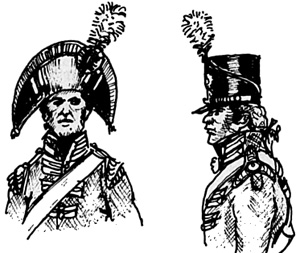 Yes, all our promises have finally come true, gentle and patient reader. The Napoleonic Rules are now out and available from us at 24 MiII Road, GiIIingham, Kent ME7 1HN at £ 1.40 per copy, which includes 20p postage & packing (which means that the price over the counter is only £ 1.20).
Yes, all our promises have finally come true, gentle and patient reader. The Napoleonic Rules are now out and available from us at 24 MiII Road, GiIIingham, Kent ME7 1HN at £ 1.40 per copy, which includes 20p postage & packing (which means that the price over the counter is only £ 1.20).
A fanfare of trumpets is perhaps appropriate because they represent a major step in our progress, as they are the first set which we have produced since Steve Curtis's death and therefore without the benefit of his talent and facilities. This has meant that we have had to make a number of concessions to the harsh outside world in keeping production costs down. The new rules are A4 format instead of the old quarto size of our previous rules -- the only reason we stuck to the smaller size was because Steve had loads of that size paper left from his printing business.
When we first planned these rules, we saw them as a set of Napoleonic Skirmish Rules, and spoke of them as such. However, as we worked through the numerous drafts and played test games we realised that once warfare is broken down to the skirmish level, and one is dealing with men as individuals rather than mere components of a regiment or battalion, the distinction between periods becomes blurred. The real differences lie in the weapons and the kind of troops being used. To capture the flavour of the Napoleonic Period, it is necessary to do so in the situation which is set up, in the uniforms and weapons of the troops, and in the types of combatants used.
The mechanics of the rules, movement, actions, firing, melee, are not unique to the Napoleonic Period alone - men have always acted and fought in this way, with only the trappings and trimmings changing. So we real ised that it was really the weapons which were the controlliing factor, hence our change to the title Flintlock and Ramrod. This period was dominated by the limitations of the Flintlock Muzzle Loader, and it is around this fact we have based these rules.
 These Rules are therefore designed to cover small scale actions, particularly at platoon and company levels, from the early 18th century to
the mid 19th century. The British fought the French
throughout the world, and especially in India and North
America between 1730 and 1760, and British Legions
consisting of troops made redundant by the Peace of Vienna
in 1815, fought in Portugal and South America well into the
second half of the 19th century using weapons covered by these Rules.
These Rules are therefore designed to cover small scale actions, particularly at platoon and company levels, from the early 18th century to
the mid 19th century. The British fought the French
throughout the world, and especially in India and North
America between 1730 and 1760, and British Legions
consisting of troops made redundant by the Peace of Vienna
in 1815, fought in Portugal and South America well into the
second half of the 19th century using weapons covered by these Rules.
The range of skirmishes in the Napoleonic Period alone is almost endless. There are the French against Cossacks 'n Russia, Mamelukes in Egypt, Spanish Guerillas in the Peninsula. The British were also in the Peninsula, of course, where the Rifle Brigade made their mark; in South America, for example the Fiasco at Rio de Janeiro; in North America burning Washington in the War of 1812; and in India fighting Maharattas, French, and Gurkhas.
The Rules follow the lines of our previous Skirmish Rules in that they are based on our percentage dice calculation system. However, the longer reloading times have caused us to modify the Time Scale, and we have also attempted to improve the Firing System by breaking away from the old close/medium/long range approach to a system more closely related to the actual performance of a weapon over the whole of its range. We have also envisaged actions involving large numbers of figures, over 100 per side as well as the smaller clashes, and new rules have been included to cover this aspect.
Because of the wide range and easy accessibiIity of books on the period we felt that our usual factual appendix would be superfluous. This has also enabled us to keep the size and therefore the cost of the rules down.
These Rules have been deliberately kept to a less detailed individual level than our other Skirmish Rules because we felt that the period lent itself more to a group skirmish than to single figures. However, the more detailed approach is covered in our other sets of rules, and should you wish to introduce the more complex ideas covered in the Colonial Period and Old West Rules then we suggest that you extract the mechanics, make the few minor modifications necessary e.g. to get the number of phases needed for actions or movements because of the longer time scale of this set of rules, and work them into your games.
If there are any questions, queries or suggestions on these or any of our rules we will be pleased to answer them providing a stamped self addressed envelope is enclosed. It is also very helpful if you layout any questions requiring an answer with room on the page for our reply.
Back to Table of Contents -- Wargamer's Newsletter # 176
To Wargamer's Newsletter List of Issues
To MagWeb Master Magazine List
© Copyright 1976 by Donald Featherstone.
This article appears in MagWeb.com (Magazine Web) on the Internet World Wide Web.
Other articles from military history and related magazines are available at http://www.magweb.com